In early September 2020, the Brazilian Central Bank released a new BRL 200,00 bill (approximately USD 37.00 considering a BRL 5.36 exchange rate) in the market, the first addition to the Brazilian currency in 18 years.
But many locals were taken aback by the banknote almost-surprise release, which caused quite a stir on social media ever since its announcement back at the end of July.
We’re going to be covering everything there is to know so far about the new R$200 bill, from why there was a need for a new banknote, to its significant features, tips on how to spot a fake note, and why the Brazilian people have mixed feelings about the release.
Why was the new BRL 200 bill released?
The Central Bank of Brazil has stated that the new banknote was released to suffice the population demand for real cash, which has exponentially increased with the COVID-19 pandemic spreading throughout the country.
Historically speaking, during times of crisis, people usually prefer real cash instead of virtual money. Many citizens strongly believe this is a safer way to pay their bills and control their expenses, amongst other things.
Aside from that, many people afraid of a possible recession and economic crisis also cashed out their trust funds from the bank and started keeping the money at home.
Central Bank of Brazils’ director, Carolina Barros, has stated that Brazil and many other countries around the world have been observing that hoarding has increased and people are keeping their savings at home since having real cash in these uncertain times is a sign of stability and security.
Those two factors combined lead up to fewer banknotes circulating in the market, a possible issue the Central Bank of Brazil is trying to avoid by printing out the new BRL 200,00 bill. This way, they can print one BRL 200,00 banknote instead of printing two BRL 100,00 notes.
This would also facilitate citizens eligible for the emergency aid program the government has implemented during the COVID-19 pandemic to cash out their money. Many people don’t have bank accounts and depend on this aid to pull through.
The release was indeed approved by the National Monetary Council (CMN), and economists believe that the country is far from re-living the ghost of past hyperinflation, with many even saying that since the economy is in retraction, inflation should stay below 2% this year.
Why has the new BRL 200 bill been under so much criticism by the Brazilian people?
Ever since it was announced on the 31st of July this year, the new BRL 200 banknote release started a significant discussion on social media regarding whether it was necessary, taking many Brazilians back to the late 80s early 90s’ when living cost was hyperinflated.
To sum things up, during the time period above, the Central Bank of Brazil used to print out banknotes with larger denominations in an attempt to make the inflation of living costs more stable and make investments more feasible.
So it was not unusual to see people driving down to the supermarket with USD 50.00 (making a quick estimate on the conversion to the then-used currency in Brazil) just to buy a loaf of bread, for example.
The money would lose its value very quickly, so the creation of banknotes with a higher purchasing power was seen as necessary to make printing more accessible and faster.
This hyperinflation issue would only be fully sorted out in 1994 and 1995 when a new currency (the currently in effect Real) was established and put into circulation, being able to stabilize the inflation.
So, the correlation between those times to what’s going on in the country today is evident to Brazil’s people, who have been watching their living costs rise month after month due to Real’s frequent devaluation in the last couple of years.
Aside from that, the new BRL 200,00 bill announcement was made out of the blue, with the citizens never being informed that this was even something the government was considering doing.
This rubbed part of the citizens the wrong way, with many adding to the theory that this banknote was released to contain possible new hyperinflation.
Due to the long country history of governmental corruption, some political parties in Brazil even tried to intervene with this release by petitioning for its suspension, alleging that the new BRL 200,00 bill issue would help tax evaders, drug dealers, and other criminals to hide their “black” money.
Why is there a Wolf printed on the new BRL 200 bill?
Unlike other currencies around the world and even past Brazilian banknotes, the prints on the Real notes are not inspired by past national culture personalities, but animals from the local fauna instead.
While the new currency was being developed back in the 90s, one reason for this choice to be made was that the families from people who were honored in previous currencies had complained about the tributes, so a new approach was necessary.
Not only that, but even if there was a personality willing to be honored, there was also no time to negotiate, as the country was suffering from hyperinflation and in dire need of the new plan to save it from its economic crisis.
So the animals from the Brazilian fauna were the perfect solution, with many species being considered to be stamped on the new banknotes, like piranhas, lambaris, and tucunarés (2 types of local fish). In the end, these were the selected animals and its respective banknotes this far:
| Denomination in BRL | Animal | Conversion to USD |
| 1 Real | Humming Bird | 0.18 cents |
| 2 Reais | Turtle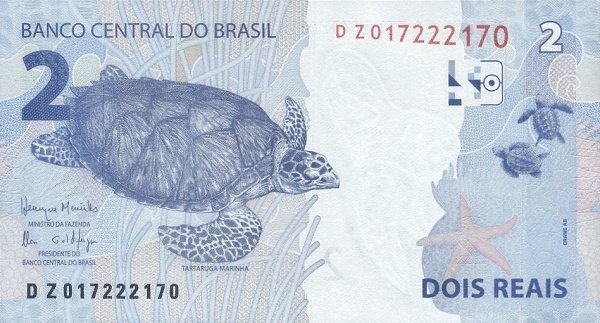 | 0.37 cents |
| 5 Reais | Heron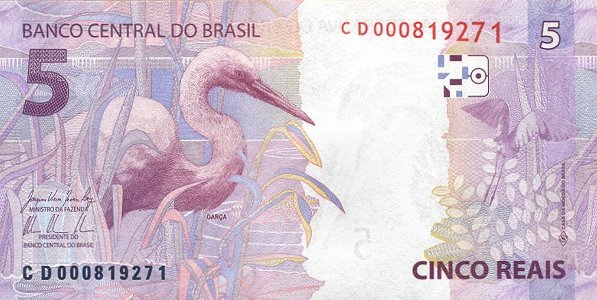 | 0.93 cents |
| 10 Reais | Macaw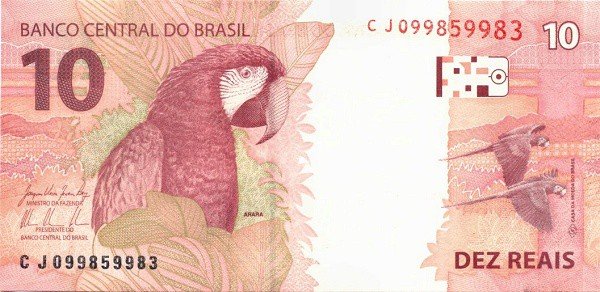 | 1.86 dollars |
| 20 Reais | Golden Lion Tamarin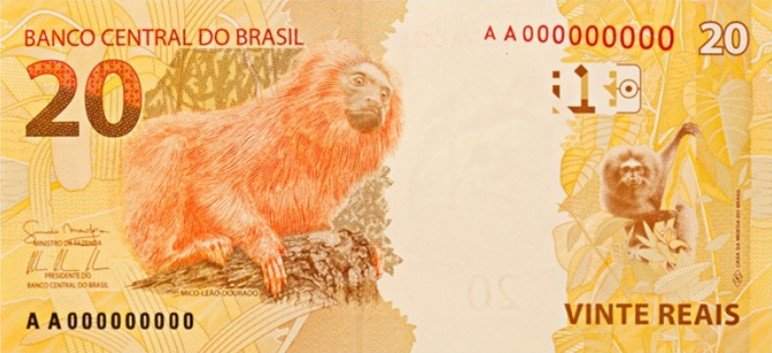 | 3.73 dollars |
| 50 Reais | Jaguar | 9.32 dollars |
| 100 Reais | Grouper Fish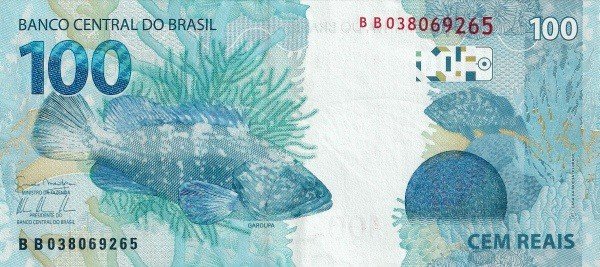 | 18.65 dollars |
| 200 Reais | Maned Wolf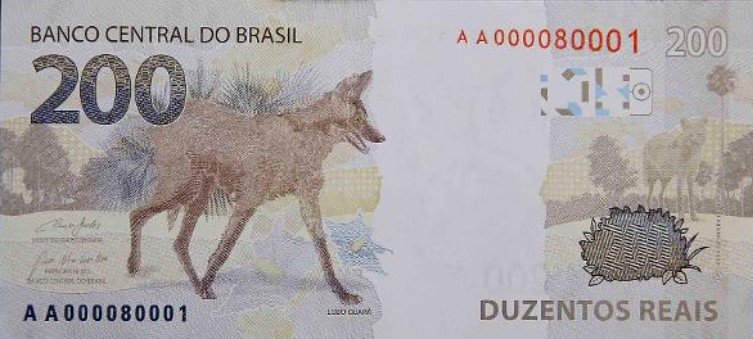 | 37.30 dollars |

The Maned Wolf as the chosen animal to be printed on the BRL 200,00 banknote was received by Brazilians with lots of memes and jokes on social media, with many stating that the “caramel mutt” should be the face of the new note, as it is the most popular and recognized (and loved!) dog breed in all Brazilian territory.
The Central Bank of Brazil decided to join in the social media fun and released a video featuring a caramel mutt announcing the new BRL 200,00 banknote, while also showing some of its security features:
When it was first implemented, the Real banknotes only had the 1, 5, 10, 50, and 100 denominations, with the BRL 2,00 and BRL 20,00 bill being released later in 2002. The BRL 1,00 bill is no longer printed ever since 2005 when it was established that it fit better as a coin instead of an actual banknote.
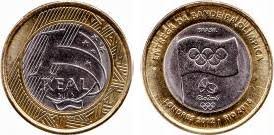
The 1 Real banknote was substituted by its coin version ever since 2005
Later in 2010, all Real banknotes went through a makeover, featuring new security elements and embossed marks. The Central Bank of Brazil noted the modifications to make the Brazilian currency safer and more robust for international use, as the country’s economy was getting more substantial and solid back then.
How To Tell If The New BRL 200 Bill Is Real Or Counterfeit?
Not just the new BRL 200,00 note, but all banknotes released after the 2010s’ makeover feature key security elements to keep the currency from counterfeit. If you’re ever in the country, here are the main pointers to identify a Real fake banknote:
Watermark
A big part of fake bills doesn’t feature a watermark, as it is one of the most challenging details to counterfeit. While holding the banknote against the light and with its front side facing you, you can see different kinds of figures on the left (next to the enumeration), which are:
– BRL 50,00 and 100,00 bills: the effigy of the Republic
– BRL 5,00 and 10 bills: the effigy of the Republic or the National Flag
– BRL 2,00: a sea turtle with the number 2
– BRL 20,00: the Golden lion Tamarin with the number 20
– BRL 200,00: the Maned Wolf with the number 200
Print Quality
The paper used to print banknotes is not as smooth as regular paper. There is an embossed feature on the Republic effigy where “Banco Central do Brasil” is written and on the banknotes denomination numerals.
Micro Prints
Using zoom lenses, you can see the letters “BC” written on the light strip next to the Republic effigy and also on the inside of the denomination numeral, which is another feature that sometimes lacks on fake banknotes.
Multi Directional Lines
There are perfectly straight, parallel, and very close to each other fine lines that can be more easily seen around the watermark area. A very precise graphic printing press is necessary to counterfeit these banknotes, which often doesn’t happen without a few flaws.
Colored Fibers
There are also little threads colored red, blue, and green that can be seen spread around the banknote. Some counterfeit notes also sport this feature, so pay attention to other red flags.
Security Strip
A vertical dark strip is built-in all banknotes (with the exception for the BRL 5,00 note), which can be easily seen by holding it up against the light.
Signatures
There are two signatures on every banknote, both being the Finance Minister and the Central Bank of Brazil’s President. Without both of them, the banknote has no legal value.
Serial Number
The banknotes’ serial number comprises letters and numbers, which is always different from one note to the other. If you happen to notice two banknotes with the same number, one of them is definitely counterfeit.
To help you take a closer look at these details, you can watch this official video from the Central Bank of Brazil on how to spot counterfeit banknotes:
We’ll keep updating this post as other relevant information regarding the new BRL 200,00 banknote appears, so stay tuned!
And if you are thinking of traveling to Brazil, check out these other posts that might help you on your journey!
- Rio in 2020: How much spending money do I need? – a guide made by locals on average expenses. We put amounts in USD and BRL to make it easier for you
- A Guide For Tipping In Brazil – always a touchy subject, how to tip on a new place. This guide will help you navigate the tipping culture in Brazil.
- Brazilian National Animal (It Is Not The Jaguar) – for nature lovers, some of our most iconic national animals (including the official one) and where to see them! And yes, we do talk about the jaguar. 😉
Cover image: Dreamstime | Agfotografia 74
